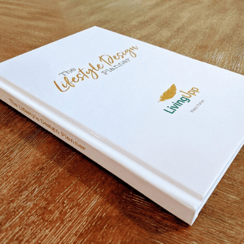The first gratitude journal I ever owned was bright orange with gold dandelions on the front. I was eager to crack it open and formally begin my gratitude journaling practice. Each morning, I’d reflect on the previous day, doing my best to recall the events and bright spots within it. I’d note kindnesses from strangers, my hot cup of coffee, the silence of the morning, and the sunshine in the afternoon.
Some days, though, I struggled to find new things to be thankful for. I’d find that I was repeating the same things over and over again, and I wondered if I was doing something wrong. But the more time I spent with the pages of my journal, the more my gratitude practice flourished. Soon, I was seeing more things to be grateful for, and I’m fairly certain it’s because I was looking for them.
The practice of gratitude journaling has become popular in recent years, and for good reason. There are some significant health benefits associated with adopting an attitude of gratitude. Gratitude journaling helps you refocus your lens, put things into perspective, and make a conscious choice to give your attention to what’s good in your life.
What is Gratitude Journaling?
Gratitude journaling is the simple act of writing down things you’re grateful for. It offers space to take note of the small blessings and acts of kindness you experience in your day-to-day life.
In his book _Thanks! How Practicing Gratitude Can Make You Happier_, author Robert Emmons suggests that gratitude requires an element of humility. When we express gratitude for others, and the ways they’ve made our lives better, we’re acknowledging that we’re not solely responsible for the good things that come our way.
Expressing gratitude within the pages of your journal can be as simple as jotting down a few things that make you happy, or as elaborate as writing letters to the individuals who have made your life better in some way.
Gratitude Journaling and Your Health
According to researchers, expressing gratitude on a regular basis can have a positive impact on your health and well-being. Here are just a few of those benefits:
Better Sleep
Expressing gratitude regularly, especially in the evening before bed, can reduce stress and improve your quality of sleep. When you’re feeling calm and relaxed, it’s much easier to drift off to sleep.
Lower Blood Pressure
Stress often triggers intense emotions that can lead to increases in heart rate and blood pressure. Researchers have found that expressing gratitude reduces stress and anxiety, which can also lower blood pressure.
Better Mood
Expressing gratitude has also been associated with improved mood. Research has shown that people who are grateful experience fewer symptoms of depression. That’s because when your mind is occupied with positive emotions, your mood often follows suit.
And if those benefits aren’t enough, there’s also some strong evidence that gratitude can boost your overall happiness.
Types of Gratitude Journaling
As with most types of journaling, there are no real rules when it comes to expressing gratitude in your journal. But here are a few different options to consider:
**Lists.** List-making is a simple journaling technique that can be completed easily and quickly. With this format, simply make a list of all the things you’re grateful for.
**Printables.** If you’re looking for something different to kickstart your gratitude practice, search the web for a downloadable/printable gratitude worksheet.
**Specialty Journals.** With the growing interest in gratitude journaling in recent years, there are plenty of specialty journals on the market. Many of them offer space to write a sentence or two each day or week, which makes it especially helpful if you’re working toward establishing a new routine.
**Write Letters.** When the focus of your gratefulness involves another person, considering writing a letter to share how they’ve had a positive impact on your life. Whether you actually send the letters or not is completely up to you.
Gratitude Journaling: A How-To Guide
Once you’ve chosen the right format for your gratitude journal, you’ll need to create a new routine that fits easily into your daily life. Here are some tips to help you establish a consistent practice:
Time
Choose a specific time of day to do your journaling. This may require you to experiment a little to determine if it makes more sense to journal in the morning or evening. Like any new habit, it will probably take some time to make it part of your permanent routine. If you struggle to be consistent, consider scheduling it on your calendar or setting a reminder on your phone.
Space
Find a quiet, cozy spot to do your journaling, and do you best to limit noise and distractions. You might even find that it helps to change the location of your journaling periodically to break up familiar routines. Sitting outside in nature can also be an inspiring place to journal.
Frequency
If you’re feeling overwhelmed by the idea of adding even one more thing to your to-do list, then you’ll be glad to know you don’t have to journal about gratitude every day. In fact, there appears to be a gratitude “sweet spot” where you can reap the most health benefits. Experts recommend limiting your gratitude journaling to just once or twice per week. Anything more frequent doesn’t appear to enhance results, and may even be counterproductive.
Mindset
Retrain your brain and focus on what’s good. When life feels busy and chaotic, it’s easy to get sidetracked by what isn’t going well. But when you focus your attention on what’s good in your life, your mindset shifts away from problems and toward solutions. Positive Psychology expert Martin Seligman recommends using the _What Went Well?_ exercise. Using the simple question “What went well?” as a journal prompt, reflect on the day and focus on all the things that were good about it.
Conclusion
Keeping a gratitude journal helps you focus on the good things in your life. Expressing gratitude regularly, even just twice a week, can help you sleep better, lower your blood pressure, reduce symptoms of depression and anxiety, and boost your overall happiness.
Information contained in this article is for educational purposes only and should not be interpreted as providing or replacing medical advice, diagnosis or treatment.
Sources:
Resources:
Journal Prompt #139 - Gratitude Journaling
Gratitude Journaling for the Health of It
Journaling Ideas: Keep a Gratitude Journal

Author bio: STACY FISHER, RDN, LD, CDCES is the founder of LivingUpp™, a lifestyle design company that teaches women how to use a self-care planning  system to create more ease and better health. She is a registered dietitian and lifestyle coach with 20+ years of experience in the healthcare industry, where she’s worked with large companies such as Dell, Boeing and Nike. Stacy is the author of The Lifestyle Design Planner, a flexible life organizer for high-achievers who value self-care and simplicity.
system to create more ease and better health. She is a registered dietitian and lifestyle coach with 20+ years of experience in the healthcare industry, where she’s worked with large companies such as Dell, Boeing and Nike. Stacy is the author of The Lifestyle Design Planner, a flexible life organizer for high-achievers who value self-care and simplicity.
NOW ON SALE!
Experience The Life-Changing Magic!



Leave Comment